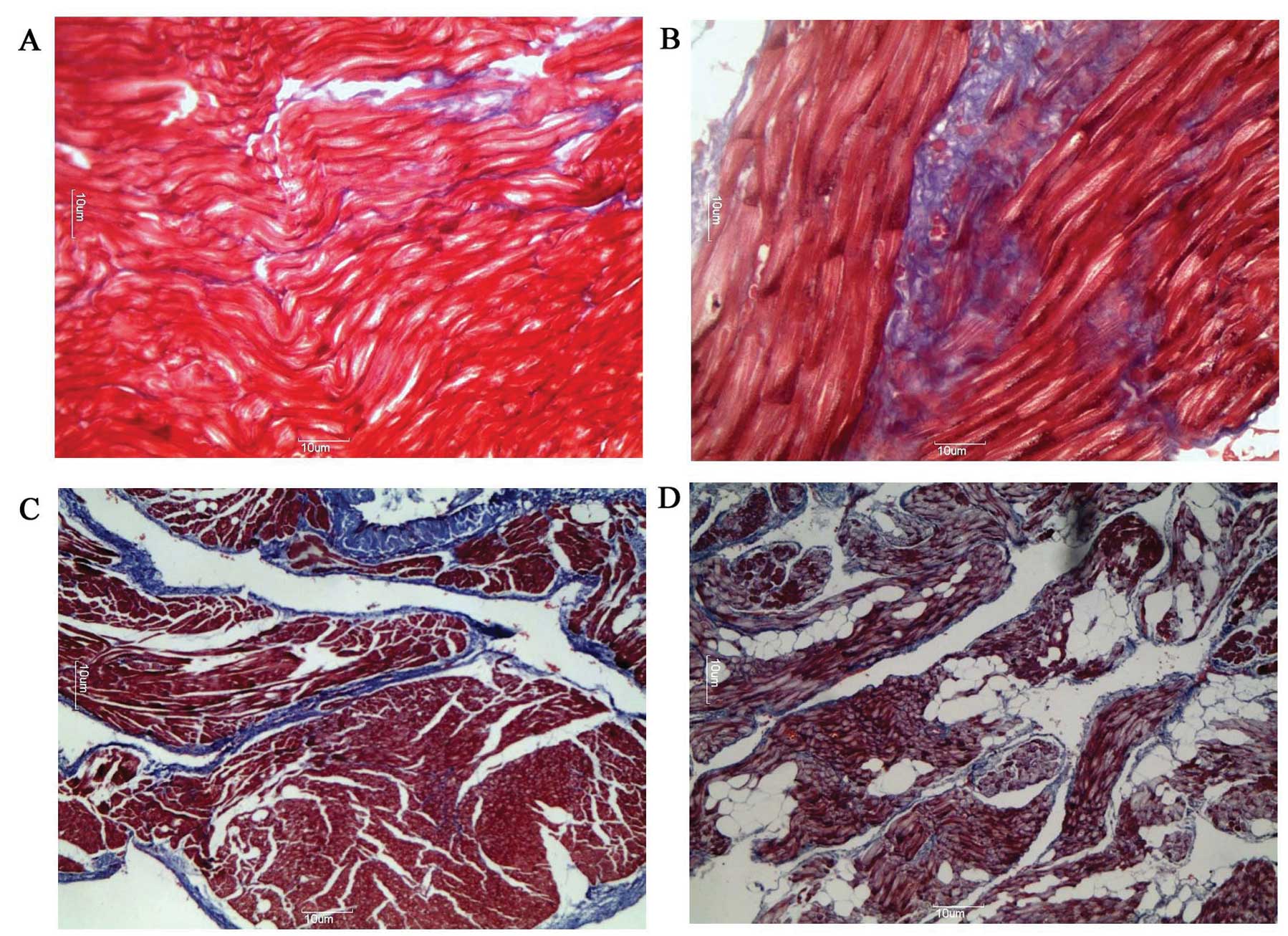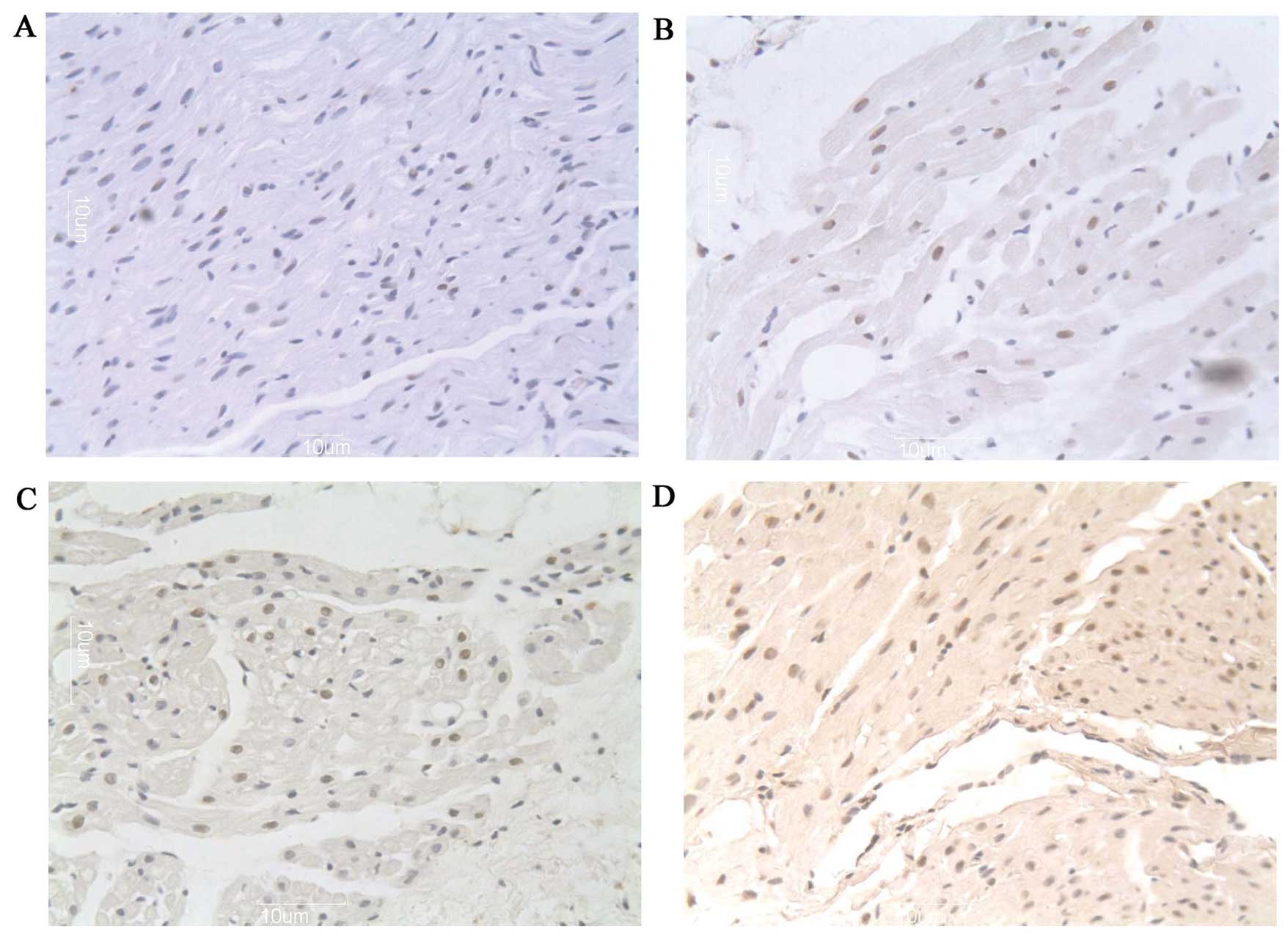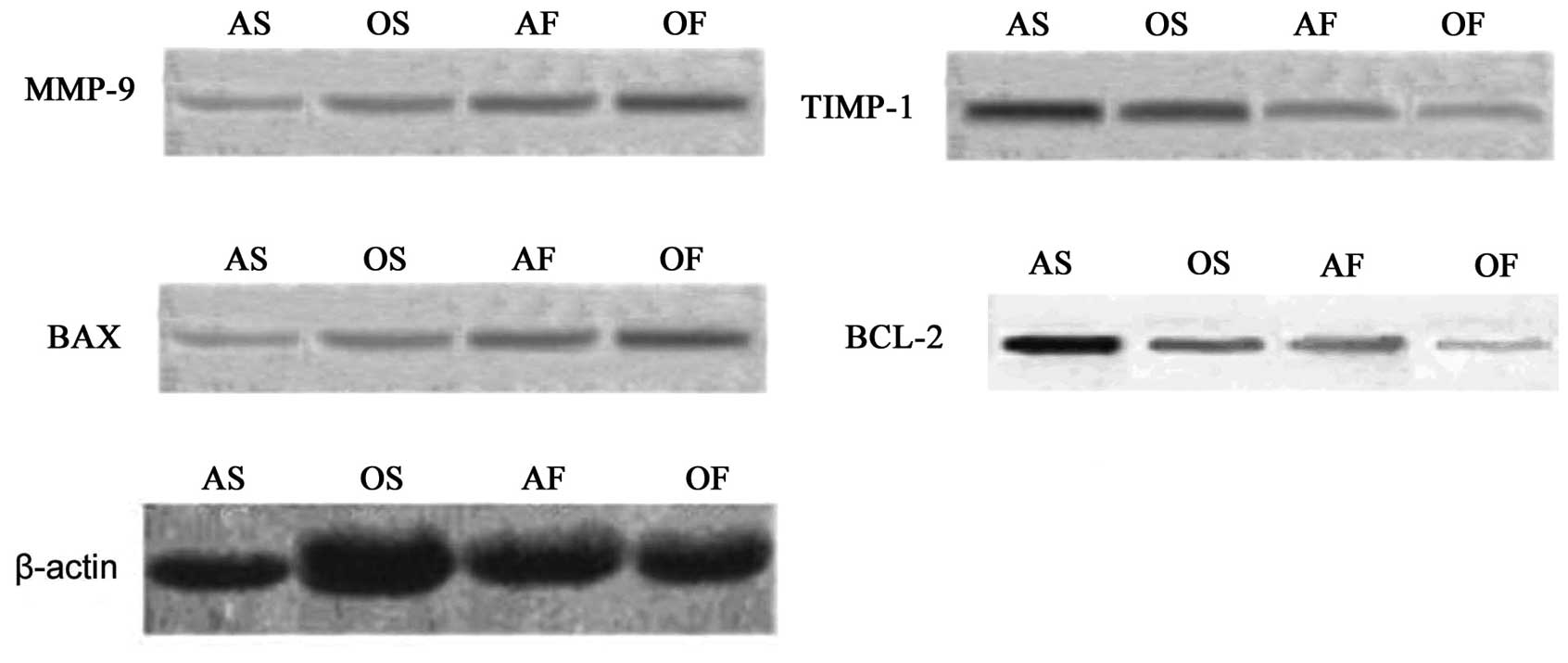|
1.
|
Nattel S: New ideas about atrial
fibrillation 50 years on. Nature. 415:219–226. 2002.PubMed/NCBI
|
|
2.
|
Chen LY and Shen WK: Epidemiology of
atrial fibrillation: A current perspective. Heart Rhythm. 4:S1–S6.
2007. View Article : Google Scholar : PubMed/NCBI
|
|
3.
|
Allessie M, Ausma J and Schotten U:
Electrical, contractile and structural remodeling during atrial
fibrillation. Cardiovasc Res. 54:230–246. 2002. View Article : Google Scholar : PubMed/NCBI
|
|
4.
|
Kostin S, Klein G, Szalay Z, Hein S, Bauer
EP and Schaper J: Structural correlate of atrial fibrillation in
human patients. Cardiovasc Res. 54:361–379. 2002. View Article : Google Scholar : PubMed/NCBI
|
|
5.
|
Everett TH, Wilson EE, Verheule S, Guerra
JM, Foreman S and Olgin J: Structural atrial remodeling alters the
substrate and spatiotemporal organization of AF: a comparison in
canine models of structural and electrical atrial remodeling. Am J
Physiol Heart Circ Physiol. 291:H2911–H2923. 2006. View Article : Google Scholar : PubMed/NCBI
|
|
6.
|
Williams GT: Programmed cell death:
apoptosis and oncogenesis. Cell. 65:1097–1098. 1991. View Article : Google Scholar : PubMed/NCBI
|
|
7.
|
Lockshin RA, Facey CO and Zakeri Z: Cell
death in the heart. Cardiol Clin. 19:1–11. 2001. View Article : Google Scholar
|
|
8.
|
Yang E, Zha J, Jockel J, Boise LH,
Thompson CB and Korsmeyer SJ: Bad, a heterodimeric partner for
bcl-XL and bcl-2, displaces bax and promotes cell death. Cell.
80:285–291. 1995. View Article : Google Scholar : PubMed/NCBI
|
|
9.
|
Verheule S, Wilson E, Everett T IV,
Shanbhag S, Golden C and Olgin J: Alterations in atrial
electrophysiology and tissue structure in a canine model of chronic
atrial dilatation due to mitral regurgitation. Circulation.
107:2615–2622. 2003.PubMed/NCBI
|
|
10.
|
Spinale FG: Myocardial matrix remodeling
and the matrix metalloproteinases: influence on cardiac form and
function. Physiol Rev. 87:1285–1342. 2007. View Article : Google Scholar : PubMed/NCBI
|
|
11.
|
Cardin S, Libby E, Pelletier P, et al:
Contrasting gene expression profiles in two canine models of atrial
fibrillation. Circ Res. 100:425–433. 2007. View Article : Google Scholar : PubMed/NCBI
|
|
12.
|
Bouzeghrane F, Reinhardt DP, Reudelhuber
TL and Thibault G: Enhanced expression of fibrillin-1, a
constituent of the myocardial extracellular matrix in fibrosis. Am
J Physiol Heart Circ Physiol. 289:H982–H991. 2005. View Article : Google Scholar : PubMed/NCBI
|
|
13.
|
Mihm MJ, Yu F, Carnes CA, Reiser PJ,
McCarthy PM, Van Wagoner DR and Bauer JA: Impaired myofibrillar
energetics and oxidative injury during human atrial fibrillation.
Circulation. 104:174–180. 2001. View Article : Google Scholar : PubMed/NCBI
|
|
14.
|
Disertori M, Latini R, Barlera S, et al:
Valsartan for prevention of recurrent atrial fibrillation. N Engl J
Med. 360:1606–1617. 2009. View Article : Google Scholar : PubMed/NCBI
|
|
15.
|
Mukherjee R, Herron AR, Lowry AS, et al:
Selective induction of matrix metalloproteinases and tissue
inhibitor of metalloproteinases in atrial and ventricular
myocardium in patients with atrial fibrillation. Am J Cardiol.
97:532–537. 2006. View Article : Google Scholar
|
|
16.
|
Anyukhovsky EP, Sosunov EA, Plotnikov A,
Gainullin RZ, Jhang JS, Marboe CC and Rosen MR: Cellular
electrophysiologic properties of old canine atria provide a
substrate for arrhythmogenesis. Cardiovasc Res. 54:462–469. 2002.
View Article : Google Scholar
|
|
17.
|
Lin CS, Lai LP, Lin JL, et al: Increased
expression of extracellular matrix proteins in rapid atrial
pacing-induced atrial fibrillation. Heart Rhythm. 4:938–949. 2007.
View Article : Google Scholar : PubMed/NCBI
|
|
18.
|
Moe GW, Laurent G, Doumanovskaia L, Konig
A, Hu X and Dorian P: Matrix metalloproteinase inhibition
attenuates atrial remodeling and vulnerability to atrial
fibrillation in a canine model of heart failure. J Card Fail.
14:768–776. 2008. View Article : Google Scholar
|
|
19.
|
Tanaka K, Zlochiver S, Vikstrom KL, et al:
The spatial distribution of fibrosis governs fibrillation wave
dynamics in the posterior left atrium during heart failure. Circ
Res. 101:839–847. 2007. View Article : Google Scholar : PubMed/NCBI
|
|
20.
|
Wit AL and Boyden PA: Triggered activity
and atrial fibrillation. Heart Rhythm. 4:S17–S23. 2007. View Article : Google Scholar : PubMed/NCBI
|
|
21.
|
Weiss JN, Qu Z, Chen PS, et al: The
dynamics of cardiac fibrillation. Circulation. 112:1232–1240. 2005.
View Article : Google Scholar : PubMed/NCBI
|
|
22.
|
Everett TH IV and Olgin JE: Atrial
fibrosis and the mechanisms of atrial fibrillation. Heart Rhythm.
4:S24–S27. 2007. View Article : Google Scholar : PubMed/NCBI
|
|
23.
|
Qu Z, Garfinkel A, Chen PS and Weiss JN:
Mechanisms of discordant alternans and induction of reentry in
simulated cardiac tissue. Circulation. 102:1664–1670. 2000.
View Article : Google Scholar : PubMed/NCBI
|
|
24.
|
Miragoli M, Gaudesius G and Rohr S:
Electrotonic modulation of cardiac impulse conduction by
myofibroblasts. Circ Res. 98:801–810. 2006. View Article : Google Scholar : PubMed/NCBI
|
|
25.
|
Koura T, Hara M, Takeuchi S, et al:
Anisotropic conduction properties in canine atria analyzed by high
resolution optical mapping: preferential direction of conduction
block changes from longitudinal to transverse with increasing age.
Circulation. 105:2092–2098. 2002. View Article : Google Scholar
|
|
26.
|
Thijssen VL, Ausma J, Liu GS, Allessie MA,
van Eys GJ and Borgers M: Structural changes of atrial myocardium
during chronic atrial fibrillation. Cardiovasc Pathol. 9:17–28.
2000. View Article : Google Scholar : PubMed/NCBI
|
|
27.
|
Mandapati R, Skanes A, Chen J, Berenfeld O
and Jalife J: Stable microreentrant sources as a mechanism of
atrial fibrillation in the isolated sheep heart. Circulation.
101:194–199. 2000.PubMed/NCBI
|
|
28.
|
Ausma J, Wijffels M, Thone F, Wouters L,
Allessie M and Borgers M: Structural changes of atrial myocardium
due to sustained atrial fibrillation in the goat. Circulation.
96:3157–3163. 1997. View Article : Google Scholar : PubMed/NCBI
|
|
29.
|
Olivetti G, Abbi R, Quaini F, et al:
Apoptosis in the failing human heart. N Engl J Med. 336:1131–1141.
1997. View Article : Google Scholar : PubMed/NCBI
|
|
30.
|
Hockenbery D, Nunez G, Milliman C,
Schreiber RD and Korsmeyer SJ: Bcl-2 is an inner mitochondrial
membrane protein that blocks programmed cell death. Nature.
348:334–336. 1990. View Article : Google Scholar : PubMed/NCBI
|
|
31.
|
Goodwin G, Taylor C and Taegtmeyer H:
Regulation of energy metabolism of the heart during acute increase
in heart work. J Biol Chem. 273:29530–29539. 1998. View Article : Google Scholar : PubMed/NCBI
|
|
32.
|
Oltvai ZN, Milliman CL and Korsmeyer SJ:
Bcl-2 heterodimerizes in vivo with a conserved homolog, bax, that
accelerates programed cell death. Cell. 74:609–619. 1993.
View Article : Google Scholar : PubMed/NCBI
|
|
33.
|
Yin XM, Oltvai ZN and Korsmeyer SJ: BH1
and BH2 domains of bcl-2 are required for inhibition of apoptosis
and heterodimerization with Bax. Nature. 369:321–333. 1994.
View Article : Google Scholar : PubMed/NCBI
|
|
34.
|
van Bilsen M, van der Vusse G and Reneman
R: Transcriptional regulation of metabolic processes: implications
for cardiac metabolism. Pflügers Arch. 437:2–14. 1998.PubMed/NCBI
|
|
35.
|
Cheng EH, Kirsch DG, Clem RJ, et al:
Conversion of Bcl-2 to a Bax-like death effector by caspases.
Science. 278:1966–1968. 1997. View Article : Google Scholar : PubMed/NCBI
|
|
36.
|
Marton A, Mihalik R, Bratincsák A, et al:
Apoptotic cell death induced by inhibitors of energy conservation.
Eur J Biochem. 250:467–475. 1997. View Article : Google Scholar : PubMed/NCBI
|
|
37.
|
Tanaka M, Ito H, Adachi S, et al: Hypoxia
induces apoptosis with enhanced expression of Fas antigen messenger
RNA in cultured neonatal rat cardiomyocytes. Circ Res. 75:426–433.
1994. View Article : Google Scholar : PubMed/NCBI
|
|
38.
|
Depre C, Rider M and Hue L: Mechanisms of
control of heart glycolysis. Eur J Biochem. 258:277–290. 1998.
View Article : Google Scholar : PubMed/NCBI
|














